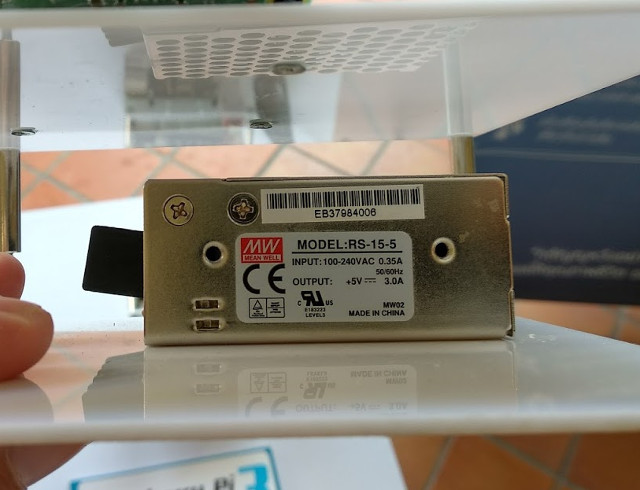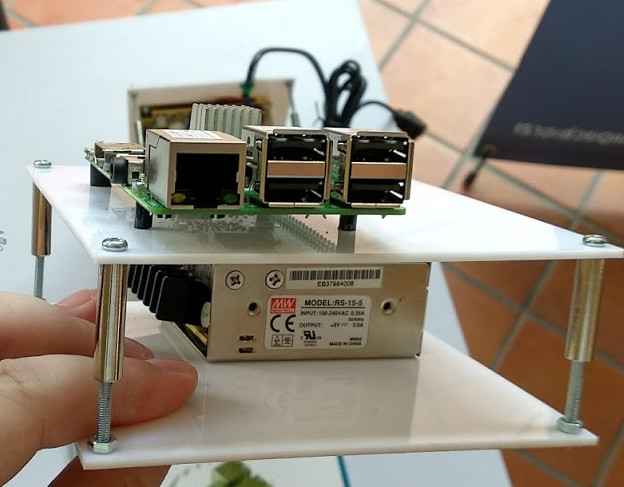While some people or organizations with lots of boards may use high-end USB hubs to power and control them, most people likely use wall adapters to power their development boards like Raspberry Pi 3, ASUS Tinkerboard, Orange Pi PC, and so on.
At least that’s what I do, except in some cases when I suspect power issues, and I go with a more powerful SMPS (switch mode power supply). I don’t use it often because it’s a large brick and expose 220V. But the other day, as I attended Chiang Mai Maker Party, I found one maker uses some tiny (and cute) power supply from a company called Mean Well to power his Raspberry Pi boards.
The model used above with RS-15-5 with takes 100-240VAC 0.35A input, and output 5VDC up to 3A. The power supply include AC Neutral, AC Live, Ground, DC V+ and DC V- pins where you can insert the wires/cables and fastened them with a screw. You’ll find the complete specifications here. Unless you can put the power supply into an enclosure, this type of power supply may not be recommended if you have young kids running around, in case they fiddle with the mains connections.
 The company meant well… when they designed the nomenclature of their power supplies, as the first number stands for the wattage, and the second for voltage. So for example, if you want a 25W power supply with 5V output, you ‘ll find RS-25-5 model. In the datasheet linked above, they have 15W power supplies from 3.3V to 48V.
The company meant well… when they designed the nomenclature of their power supplies, as the first number stands for the wattage, and the second for voltage. So for example, if you want a 25W power supply with 5V output, you ‘ll find RS-25-5 model. In the datasheet linked above, they have 15W power supplies from 3.3V to 48V.
RS-15-5 power supply pictured above can be purchased for $8 on Amazon US, and plenty of sellers offer it on Aliexpress or eBay. More models can be found on their website.

Jean-Luc started CNX Software in 2010 as a part-time endeavor, before quitting his job as a software engineering manager, and starting to write daily news, and reviews full time later in 2011.
Support CNX Software! Donate via cryptocurrencies, become a Patron on Patreon, or purchase goods on Amazon or Aliexpress. We also use affiliate links in articles to earn commissions if you make a purchase after clicking on those links.





Mean Well is a very reputable source for PSUs, we use a lot of their 5V and 24V models (the latter to be used with passive PoE and cheap step-down converters at the device side).
They all feature adjustable output voltage, see on top picture the white thing next to the screw terminals (called ‘+V ADJ’ in schematic) so even if you happen to power boards that only feature crappy Micro USB you simply adjust output voltage to 5.3V and should be done (IIRC it’s up to 5.5V but everything above 5.25V could cause damage with really good cables between PSU and device).
I can see they have a RS-150-5 model, but rated 130 Watts, so you could probably safely power a dozen boards with a single PS.
The spec indeed look nice. The load regulation is pretty good, and they even placed a Zener diode to clamp the output. It should avoid the problems we’ve seen many times with cheap regulators causing a huge voltage surge on output after the load falls (eg: instantly going from 100% CPU to idle). The low-power ones could fit into a small plastic enclosure, that might be something to do with a 3D printer if the vendor is not willing to produce such models themself ; at 15W and 80% efficiency, that’s only 3W to dissipate over the whole surface, it’s perfectly manageable.
@cnxsoft
Yes, I used the RS-75-5 last year to power a bunch of SBC from this single PSU (using thick wires on the screw terminals and then soldered female jumper wires to this to power various boards through GPIO header. Back at that time I was neither aware that usual jumper wires have pretty thin cable diameters and that on some SBC the GPIO header is rotated by 180° — I successfully damaged somehow my first Orange Pi One this way 😉 )
BTW: you’re talking above only about the RS models (S == single output) but they also have RD variants (D == dual output). RD-50A for example is 5V/12V (50W max rating) while RD-50B is 5V/24V and so on…
With an RD-50A one or more dev boards and 3.5″ HDDs can be powered at the same time and when so called ‘staggered spinup’ is implemented this works very well even with up to 4 HDDs (but then disk spindown becomes challenging since if you allow disks to enter standby/sleep state and $something later tries to wake them up all at the same time the 3A on the 12V rail will not be sufficient to compensate for the huge peak consumption at spinup).
But the RD line is more expensive so maybe using a 12V PSU with buck converter to get an additional lower voltage is less expensive.
They also do models with UPS functionality, e.g. PSC-35A-C.
The Meanwell range is good enough that they do attract fakes though, so be careful!
In Europe also for sale on pollin.de
So what’s a good PSU for powering, say, 4x HDDs which i want to connect to one board to create a NAS?
We also use Meanwell in our systems. Do be careful of buying fakes, there are many very similar supplies available that are not UL rated.
Meanwell has every approval needed to use it anywhere in the world.
i’m a long time user of rd-65a (65W, dual voltage 5 and 12) and rs-50-5 (50W, 5v). they work great as a tinkerer power source.
@roel: in eu http://tme.eu store is good source of them.
@fossexplorer: just count your watts on 5 and 12v lines then select the psu satisfying amps on both lines +20% safety margin (there is plenty of models to choose from). with hdds its better to go with dual voltage models (unless you only use ssds)
Depending on disk type this can be anything. 3.5″ HDD (and some 2.5″ server HDD) require both 5V and 12V, usual 3.5″ HDD need up to 2A on the 12V rail at spinup time so you can easily end up with a 100W requirement for 4 x 3.5″ disks (that will run pretty inefficient the rest of the time since then working somewhere below 25% rated load).
BTW: Currently the majority of suitable ‘boards to create a NAS’ with 4 disks can be powered with 12V anyway (EspressoBin, Helios4, Clearfogs — none of them relies on 5V powering since it’s well known what a sh*t show this can be especially with lousy DC-IN connectors like Micro USB)
Meanwell has been my “go-to” source for power-supplies for several years. The only problem I have ever had with one of their products – a 12v 5a supply – was my fault. General purpose safety hint: Make sure what you think is your ground wire is actually your ground wire. 28AWG wire makes a interesting smoke pattern when it vaporizes. And it is very difficult to “blue-smoke” a Meanwell.
Based on my experience with power supplies from the likes of Delta, TDK Lambda, Cosel, and Phoenix, I would say that Mean Well is about as cheap as you can get for a decent power supply.
I have a MW LRS-200-5 for powering LED lights, and while it works fine, I wouldn’t use it in a high vibration environment, since the build quality seems a little flimsy (but fine if you don’t abuse it). I also have a DIN-rail mount MW MDR-60-5, with much better build quality, but then again, it costs more per watt than the LRS.
So how you can tell a fake from a real one? I’ve seen some cheap Meanwell supplies on Ebay. They mention Meanwell and the products have stickers and all, but I can’t tell a fake from a real one. I’ve bought LRS-100-24 for LED light applications..
@TonyT
LRS-200-5 isn’t good for LEDs. Even 12V wastes lots of power on cables. I prefer 12V led strips split in two blocks so that 24V can power them. The losses in cables are much lower. I can’t even imagine how bad 5V must be.
@Jerry
The PCB layouts in the fakes don’t match the real ones. The fakes work, they just don’t have all of the actual safety approvals a real one does. The price for Meanwell at Future Electronics is not much more than Ebay and the ones from Future will be legit for sure. Future is like $2 more.
It is not like there are millions of fakes, I’ve only seen one in the last ten years. But I don’t buy from Ebay either. Also, it is more like likely the really cheap ones on Ebay are used instead of fake.
@Jerry
I’m using it for WS2812 LED strips, so it has to be 5V, and, yeah, it’s a little overkill, but gives me a bit of overhead for the future (and 200W was the biggest affordable P/S without a fan)
I bought both my MW’s from Mouser, so I’m sure they’re legit. BTW, for DIN rail, some of the Delta models aren’t much more than MW for the same specs.
@Jon Smirl
“Works” is a bit dubious considering many MW PSUs specify over/under current/voltage protections on both inputs and outputs that other (cheaper) power-supplies just don’t have.